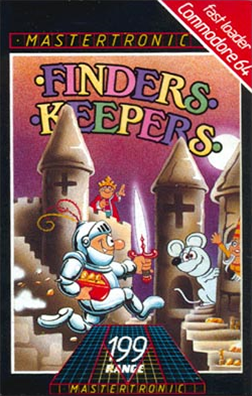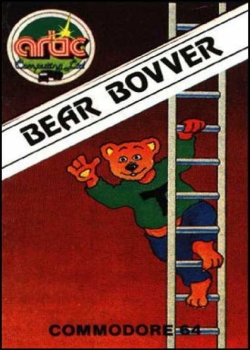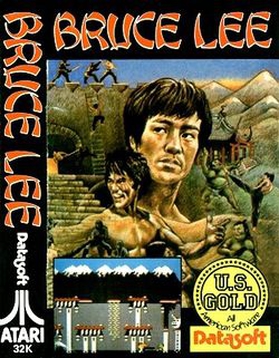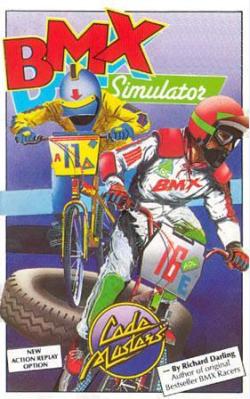Currah was a British computer peripheral manufacturer, famous mainly for the speech synthesis ROM cartridges it designed for the ZX Spectrum, Commodore 64, and other 8-bit home computers of the 1980s.

Sabre Wulf is an action-adventure game released by British video game developer Ultimate Play the Game for the ZX Spectrum home computer in 1984. The player navigates the pith-helmeted Sabreman through a 2D jungle maze while collecting amulet pieces to bypass the guardian at its exit. The player does not receive explicit guidance on how to play and is left to decipher the game's objectives through trial and error. Sabreman moves between the maze's 256 connected screens by touching the border where one screen ends and another begins. Each screen is filled with colourful flora, enemies that spawn at random, and occasional collectibles.

3D Monster Maze is a survival horror computer game developed from an idea by J.K. Greye and programmed by Malcolm Evans and released in 1981 for the Sinclair ZX81 platform with the 16 KB memory expansion. The game was initially released by J. K. Greye Software in December 1981 and re-released in 1982 by Evans' own startup, New Generation Software. Rendered using low-resolution character block "graphics", it was one of the first 3D games for a home computer, and one of the first games incorporating typical elements of the genre that would later be termed survival horror.

Game Over is an action video game developed by Dinamic Software and published by Imagine Software in 1987. It was released for the Amstrad CPC, Commodore 64, MSX, Thomson TO7, and ZX Spectrum. The game includes some adventure game elements. A prompted unrated sequel, Game Over II, was released in 1987.

Eureka! is a video game for the Commodore 64 and ZX Spectrum computers, written by Ian Livingstone, developed by Novotrade for Andromeda Software and published by Domark in 1984.

Artic Computing was a software development company based in Brandesburton, England from 1980 to 1986. The company's first games were for the Sinclair ZX81 home computer, but they expanded and were also responsible for various ZX Spectrum, Commodore 64, BBC Micro, Acorn Electron and Amstrad CPC computer games. The company was set up by Richard Turner and Chris Thornton. Charles Cecil, who later founded Revolution Software, joined the company shortly after it was founded, writing Adventures B through D. Developer Jon Ritman produced a number of ZX81 and Spectrum games for Artic before moving to Ocean Software.

Finders Keepers is a video game written by David Jones and the first game in the Magic Knight series. It was published on the Mastertronic label for the ZX Spectrum, Amstrad CPC, MSX, Commodore 64, and Commodore 16 in 1985. Published in the United Kingdom at the budget price of £1.99. Finders Keepers is a platform game with some maze sections.

Bug-Byte Software Ltd. was a video game company founded in 1980 in Liverpool, initially producing software for the Acorn Atom and ZX80. Bug-Byte's first hit was Don Priestley's Mazogs which was one of the most successful titles for the ZX81. In 1983, it published Manic Miner, considered to be one of the most influential platform games of all time. The company went into liquidation in 1985 but their name and logo were purchased by Argus Press PLC for use as a budget software label.

Nodes of Yesod is a video game developed and published by Odin Computer Graphics in 1985. The game is similar in style to Underwurlde by Ultimate Play the Game, which was released a year earlier, and Metroid which was released the following year, in 1986.
Crystal Computing, later renamed Design Design, was a British video game developer founded in 1982 by Chris Clarke and Ian Stamp while students at the University of Manchester. Graham Stafford, Neil Mottershead, Simon Brattel and Martin Horsley, joined the company as it expanded. The company's first software release was a compilation of games for the Sinclair ZX81, though it was with the ZX Spectrum that Crystal found its greatest success. A deal with the machine's manufacturer Sinclair to distribute Crystal's Zeus Assembler gave the company sufficient funds for a major marketing campaign for their next product, Halls of the Things, an arcade adventure game that became their most successful title.

Aliens: The Computer Game is a 1986 video game developed by Software Studios and published by Electric Dreams Software initially for Amstrad CPC, Commodore 64 and ZX Spectrum. It is based on the film of the same title. Ports for the Commodore 16 and MSX were developed by Mr. Micro and published in 1987.
DK'Tronics Ltd was a British software and hardware company active during the 1980s. It primarily made peripherals for the ZX Spectrum and Amstrad CPC but also released video games for the ZX81, ZX Spectrum, Commodore 64, VIC-20, BBC Micro, Memotech MTX, MSX and Amstrad platforms.
Don Priestley is a teacher and former video game programmer who wrote over 20 commercial games for the ZX81 and ZX Spectrum home computers between 1982 and 1989. Despite successful releases for DK'Tronics, such as 3D Tanx and Maziacs, Priestley returned to teaching in the late 1980s, claiming changes in the video game industry did not suit his style of work.

180 is a darts video game released for the ZX Spectrum, Commodore 64, Amstrad CPC, and Atari 8-bit computers in 1986 and MSX in 1987.

Bear Bovver is a platform game written by Jon Ritman for the ZX Spectrum and published in 1983 by Artic Computing. A Commodore 64 port was released in 1984. Bear Bovver is a BurgerTime clone, where batteries take the place of the burger ingredients.

Bruce Lee is a platform game written by Ron J. Fortier for Atari 8-bit computers and published in 1984 by Datasoft. The graphics are by Kelly Day and music by John A. Fitzpatrick. The player takes the role of Bruce Lee, while a second player controls either Yamo or alternates with player one for control of Bruce Lee.

BMX Simulator is a racing video game designed by Richard Darling and released by Codemasters in 1986 for the Commodore 64. It is part of a series of games that includes ATV Simulator, Grand Prix Simulator, Professional Ski Simulator, and a sequel: Professional BMX Simulator. BMX Simulator was ported to the Amiga, Atari 8-bit computers, Atari ST, Amstrad CPC, MSX, ZX Spectrum, Commodore Plus/4 and Commodore 16.

Light Force is a 1986 vertically scrolling shooter designed by Greg Follis and Roy Carter, developed by their company Gargoyle Games, and published under their Faster Than Light imprint. It was released for the Amstrad CPC, Commodore 64, and ZX Spectrum platforms.

Survivors is a puzzle video game published by Atlantis Software in 1986 for the ZX Spectrum. It was ported to the MSX, Atari 8-bit computers, Commodore 64, Commodore 16, Acorn Electron, and BBC Micro and the Amstrad CPC (1988). It is based on the "rocks and diamonds" mechanics of Boulder Dash.
















